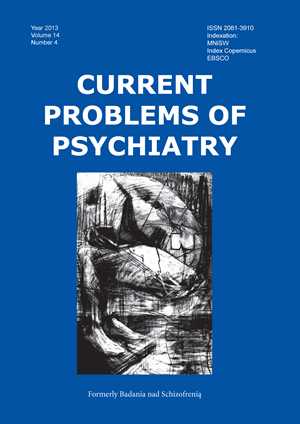Psychosocial effects of mandibular prognathism treatment with the use of bilateral sagittal split osteotomy
Abstract
Mandibular prognathism is a dentofacial deformity, in which the most pronounced feature is mandibular anterior excess. Unfavorable psychosocial effect deriving from unaesthetic facial appearance is the major indication for treatment of dentofacial deformities but other important factors are disturbed mastication, speech, pain and temporomandibular joint dysfunction. Bilateral sagittal split osteotomy (BSSO) is a popular technique among several methods utilized in tratment of dentofacial deformities including mandibular prognathism. The aim of this paper was the evaluation of impact of surgical correction of mandibular prognathism with use of BSSO on self-assessment of facial esthetics, mastication, general health, social interactions in conjunction with improvement of wellbeing. The material was the medical records of 54 patients treated for mandibular prognathism in The Department of Oral and Maxillofacial Surgery at The Medical University of Lublin. Two questionnaires and one psychological test were utilized to assess the orthodontic-surgical impact on patients’ physical and psychological function. In the evaluated group of patients considerable increase in self-assessment and self-confidence was noted after surgical treatment. They also pointed at better social interactions postoperatively in comparison with the presurgical period as well as less constraint during meal consumption. Moreover, speech improvement was noted in the evaluated group of patients. In conclusion, it was found that in majority of evaluated patients there was improvement of self-acceptance which reflects high degree of satisfaction obtained from the treatment.
References
1. Karłowska I. (red). Zarys współczesnej ortodoncji. PZWL, Warszawa, 2002.
2. Kryst L. (red). Chirurgia stomatologiczna. PZWL, Warszawa, 1981.
3. Masztalerz A. (red). Zarys ortopedii szczękowej – ortodoncji. PZWL, Warszawa, 1981.
4. Proffit WR., Fields HW. (red). Ortodoncja współczesna. Czelej, Lublin, 2001.
5. Zapała J., Szczurowski P., Szyper-Szczurowska J., Dubis P., Dyras M. Taktyka postępowania u chorych z wadami gnatycznymi. Porad Stomatol, 2005, 5, 21-24.
6. Proffit WR., White RP., Sarver DM. (red). Contemporary treatment of dentofacial deformity. Mosby, St. Louis, 2003.
7. Hunt OT., Johnston CD., Hepper PG., Burden DJ. The psychosocial impact of orthognathic surgery: a systematic review. Am J Orthod Dentofacial Orthop, 2001, 120, 490-497.
8. Lanigan DT., Hohn FI. Facial nerve injuries after sagittal split mandibular ramus osteotomies for advancement: a report of 2 cases and review of the literature. J Oral Maxillofac Surg, 2004, 62, 503-507.
9. Shaw WC. The influence of children's dentofacial appearance on their social attractiveness as judged by peers and lay adults. Am J Orthod, 1981,79,399-415.
10. Ackerman JL., Proffit WR. The characteristics of malocclusion: a modern approach to classification and diagnosis. Am J Orthod, 1969, 56, 443-454.
11. Łabiszewska-Jaruzelska F. (red). Ortopedia szczękowa. Zasady i praktyka. PZWL, Warszawa, 1995.
12. Segner D., Hasund A. Indywidualna kefalometria. Med Tour Press International, Warszawa, 1996.
13. Tomaszewski T., Cecharz Z., Buczarski B., Dobieżyńska B. Prognacja żuchwy: leczenie ortodontyczno-chirurgiczne. Ortodoncja współczesna, 2000, 2, 121-124.
14. Zent W., Knapp S. Skeletal changes after orthognathic surgery, planning surgical results. Europ J Orthod, 2000, 22, 627-628.
15. McNamara JA., Brudon WL. (red). Orthodontics and Dentofacial Orthopedics. Needham Press, Ann Arbor, 2001.
16. Fonseca RJ. (red). Oral and maxillofacial surgery. Orthognathic surgery (vol. 2). Saunders, Philadelphia, 2000
17. Lazaridou-Terzoudi T., Kiyak HA., Moore R., Athanasiou AE., Melsen B. Long-term assessment of psychologic out-comes of orthognathic surgery. J Oral Maxillofac Surg, 2003, 61, 545-552.
18. Popielski K. (red). Studia z logoteorii i logoterapii. RW KUL, Lublin, 1987
19. Phillips C, Broder HL, Bennett ME. Dentofacial disharmony: motivations for seeking treatment. Int J Adult Orthodon Orthognath Surg, 1997, 12, 7-15.
20. Rivera SM., Hatch JP., Dolce C., Bays RA., Van Sickels JE., Rugh JD. Patients' own reasons and patient-perceived recommendations for orthognathic surgery. Am J Orthod Dentofacial Orthop, 2000, 118 134-141.
21. Proffit WR., Phillips C., Dann C 4th. Who seeks surgical-orthodontic treatment? Int J Adult Orthodon Orthognath Surg, 1990, 5, 153-160.
22. Cunningham SJ., Hunt NP., Feinmann C. Psychological aspects of orthognathic surgery: a review of the literature. Int J Adult Orthodon Orthognath Surg, 1995, 10 159-172.
23. Adams GR. Physical attractiveness, personality, and social reactions to peer pressure. J Psychol, 1977, 96, 287-96.
24. Dion K., Berscheid E., Walster E. What is beautiful is good. J Pers Soc Psychol. 1972, 24, 285-290.
25. Walster E., Aronson V., Abrahams D., Rottman L. Importance of physical attractiveness in dating behavior. J Pers Soc Psychol, 1966, 4, 508-516.
26. Salvia J., Sheare JB., Algozzine B. Facial attractiveness and personal-social development. J Abnorm Child Psychol, 1975, 3, 171-178.
27. Clifford MM., Walster E. The effect of physical attractiveness on teacher expectations. Sociol Educ, 1973, 46, 248-258.
28. Finlay PM., Atkinson JM., Moos KF. Orthognathic surgery: patient expectations; psychological profile and satisfaction with outcome. Br J Oral Maxillofac Surg, 1995, 33, 9-14.
29. Hatch JP., Rugh JD., Bays RA., Van Sickels JE., Keeling SD., Clark GM. Psychological function in orthognathic surgical patients before and after bilateral sagittal split osteotomy with rigid and wire fixation. Am J Orthod Dentofacial Orthop, 1999, 115, 536-543.
30. Edgerton MT. Jr, Knorr NJ. Motivational patterns of patients seeking cosmetic (esthetic) surgery. Plast Reconstr Surg, 1971, 48, 551-557.
31. Hay GG. Psychiatric aspects of cosmetic nasal operations. Br J Psychiatry, 1970, 116, 85-97.
32. Rivera SM., Hatch JP., Rugh JD. Psychosocial factors associated with orthodontic and orthognathic surgical treatment. Semin Orthod, 2000, 6, 259-269.


